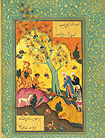Three Empires (1500–1900 CE)
From the sixteenth to the nineteenth century, three major empires ruled classical lands of Islam: the Ottoman with its capital in Istanbul, the Safavid with its capital in the Iranian city of Isfahan, and the Mughal with its capital in Delhi. The Ottomans created a new language, Ottoman Turkish, that mixed Persian, Arabic, and Turkish, employed an Arabic script, and gave rise to its own stunning version of ghazal, a rhyming poem usually about love similar to a sonnet. Persian ghazal writers in the Mughal empire developed a new “Indian style” of ghazal especially appreciated by the Ottoman poets. In the eighteenth century, a new ghazal tradition developed in Urdu, a language made up of Indic, Persian, Turkish, and Arabic elements and written in an Arabic script. An educated person was expected to know and be able to compose poems in several major languages, even as the Arabicate, Persianate, Turkic, and Indic literary galaxies competed, collaborated, and intermingled across political boundaries.

 Michael Sells
Michael Sells
John Henry Barrows Professor of Islamic History and Literature, Divinity School, The University of Chicago
Guiding Questions
1. When was the Age of Voice, and what two major areas of concern dominated the Age of Voice?
2. How did literary traditions reflect tension between different empires in the Middle East from the sixteenth to nineteenth centuries CE?
3. What kind of impact has conflict between Middle Eastern and other cultures had Middle Eastern literary movements, both in the early part and final centuries of the second millennium CE?


 Print Page
Print Page

